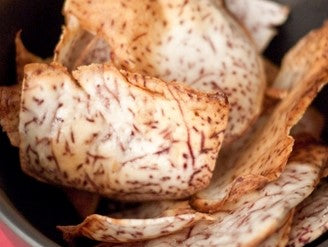Taro Chips Oven Baked
Taro Chips Oven Baked
Making taro chips, a popular snack in many parts of Asia, is easier than you think and the result is a crunchy, low-fat treat perfect for late-night munchies.
Ready in: 40 minutes
Serves: 4
Complexity: very-easy
kcal: 162
Share

Ingredients
1 taro root
Rice bran oil spray
SIDS SALT & PEPPER
Directions
Preheat the oven to 200°C. Using a peeler, remove the rough outer surface of the taro root. Using a mandolin slicer, (or cleaver) slice the Taro into very thin and even slices. Spray both sides of each slice with an oil mister. Bake for about 20 minutes. (until the chips turn golden brown) Let cool.
Sprinkle with SIDS SALT & PEPPER and serve.
History: This plant and its root is generally called taro, but it has different names in different countries like for instance eddoe, or malanga. The plant is called tales in Java, cocoyam in Ghana, taro in Tahiti, ndalo in Fiji, talo in Samoa, gabi in the Philippines, colcas in Arabic, kolokasi or kolokas in Cyprus, kalo in Hawaii and amateke in Rwanda. Taro is often referred to as "elephant ears" when grown as an ornamental plant.
Taro is one of the most ancient cultivated crops. Taro is found widely in tropical and subtropical regions of South Asia, East Asia, Southeast Asia, Papua New Guinea and northern Australia and is highly polymorphic, making taxonomy and distinction between wild and cultivated types difficult. It is believed that they were domesticated independently multiple times, with authors giving possible locations as New Guinea, Mainland Southeast Asia, and northeastern India, based largely on the assumed native range of the wild plants. However, more recent studies have pointed out that wild taro may have a much larger native distribution than previously believed and wild breeding types may also likely be indigenous to other parts of Island Southeast Asia.
Archaeological traces of taro exploitation have been recovered from numerous sites, though whether these were cultivated or wild types can not be ascertained. They include the Niah Caves of Borneo, dated to <40,000 BC; Ille Cave of Palawan, dated to at least c. 11,000 BC; Kuk Swamp of New Guinea, dated to 10,200 to 9,910 cal BC; and Kilu Cave in the Solomon Islands dated to around c. 28,000-20,000 BC. It should be noted that in the case of Kuk Swamp, there is evidence of formalized agriculture emerging by about c. 10,000 BC, with evidence of cultivated plots, though which plant was cultivated remains unknown.
Taro were carried into the Pacific Islands by Austronesian peoples from around 1300 BC, where they became a staple crop of Polynesians, along with other types of "taros", like Alocasia macrorrhizos, Amorphophallus paeoniifolius, and Cyrtosperma merkusii. They are the most important and the most preferred among the four, because they were less likely to contain the irritating raphides present in the other plants. Taro is also identified as one of the staples of Micronesia, from archaeological evidence dating back to the pre-colonial Latte Period (c. 900 - 1521 AD), indicating that it was also carried by Micronesians when they colonized the islands. Taro pollen and starch residue have also been identified in Lapita sites, dated to around c. 3,050 - 2,500 cal BC.

